Why Maurice Sendak's stories were so scary
Loading...
Fifty years ago, a little boy watched as his safe, reassuring bedroom grow into a jungle home to beasts more unruly than he was – the kinds of beings that “roared their terrible roars and gnashed their terrible teeth and rolled their terrible eyes and showed their terrible claws.”
That boy was Max, the misbehaved protagonist of Maurice Sendak’s 'Where The Wild Things Are,' the 1963 children’s book that revolutionized the genre to include not just sugar and spice and all things nice but all the nightmares that children’s authors had once left to the grown-ups' world.
Maurice Sendak, who died last May, would have celebrated his 85th birthday Monday. His life’s work is being honored in a Google Doodle that sketches out his otherworldly creatures, un-childlike fangs and claws and all.
Mr. Sendak, whose much-lauded work was sometimes banned for its unsanitized take on the children’s genre, did not believe in childhood – at least not childhood in the way in which it is conventionally talked about, glossed in nursery-appropriate hues.
“In the discussion of children, and the lives of children, and the fantasies of children, and the language of children, I said anything I wanted, because I don’t believe in children,” he said, in the documentary, 'Tell Them Anything You Want.' “I don’t believe in childhood. I don’t believe there’s a demarcation of ‘you mustn’t tell them this, you mustn’t tell them that.’ You tell them anything you want.”
“Just tell them if it’s true. If it’s true, you tell them,” he said.
So Sendak’s stories are truthful, telling tales of a world that is not always kind or fair or good. Max, perhaps Sendak’s most famous character for his romp into a very un-Disney like world of monsters, is not the princely hero of the classic fairy tale, and he does not belong to a traditional, obviously moral tale. Max’s mastery of the riotous Wild Things, and his decision to leave the imaginative place behind and return home to the warm meal he had been sent to bed without, is ambiguously moral. Much as we wish for it, it does not deliver a neat aphorism to guide us in tough ethical times. That, perhaps, is part of the point.
Sendak’s work makes demands on the child's moral life, introducing his youthful readers to worlds where things are not painted in blacks and whites, where a flexible mind and a little bit of exploration is necessary to come up with ethical answers. His are books that free up the child’s imagination, that allow it to go wandering into all its sublime, sometimes nightmarish corridors. That, after all, is where the Wild Things are.







